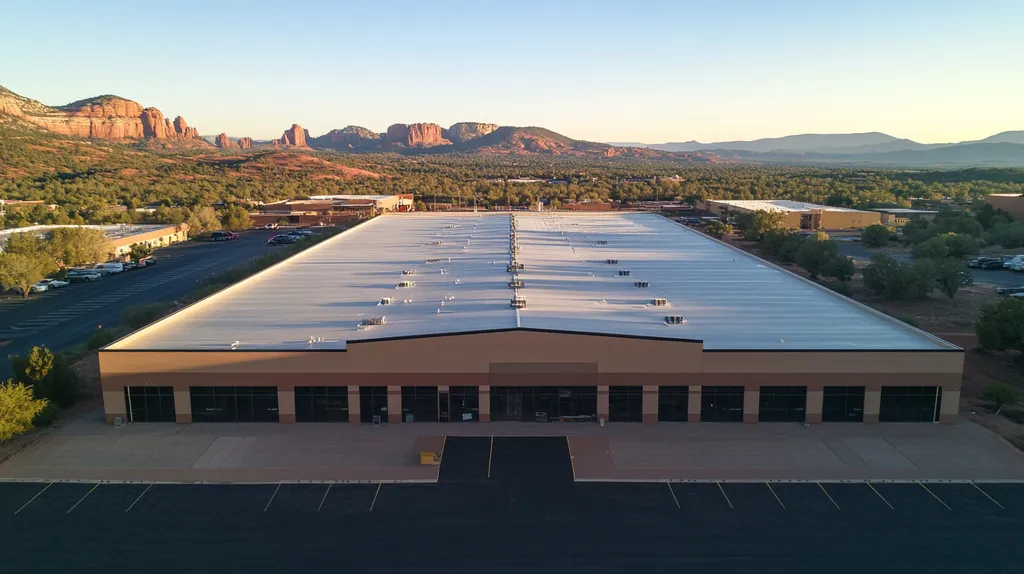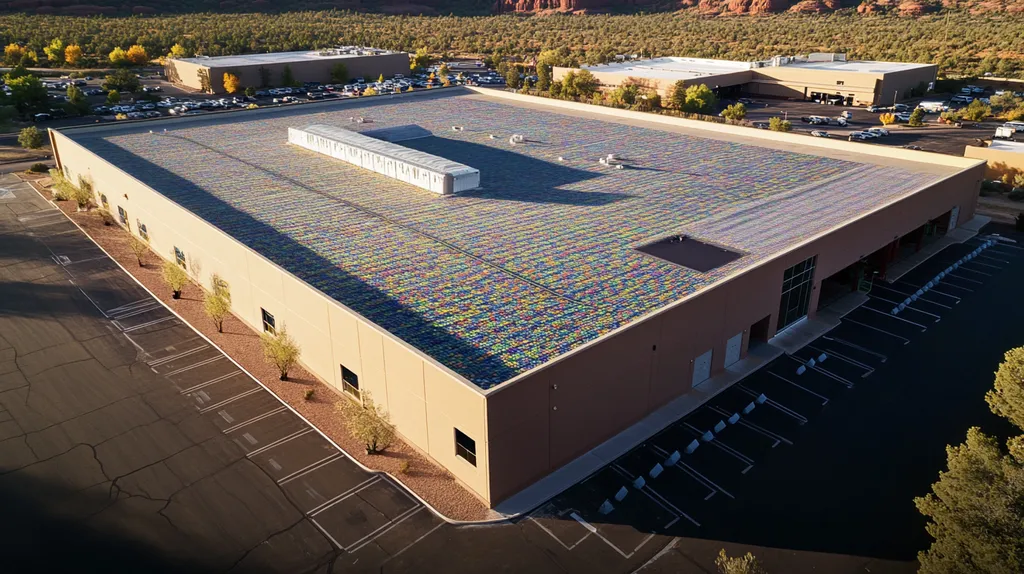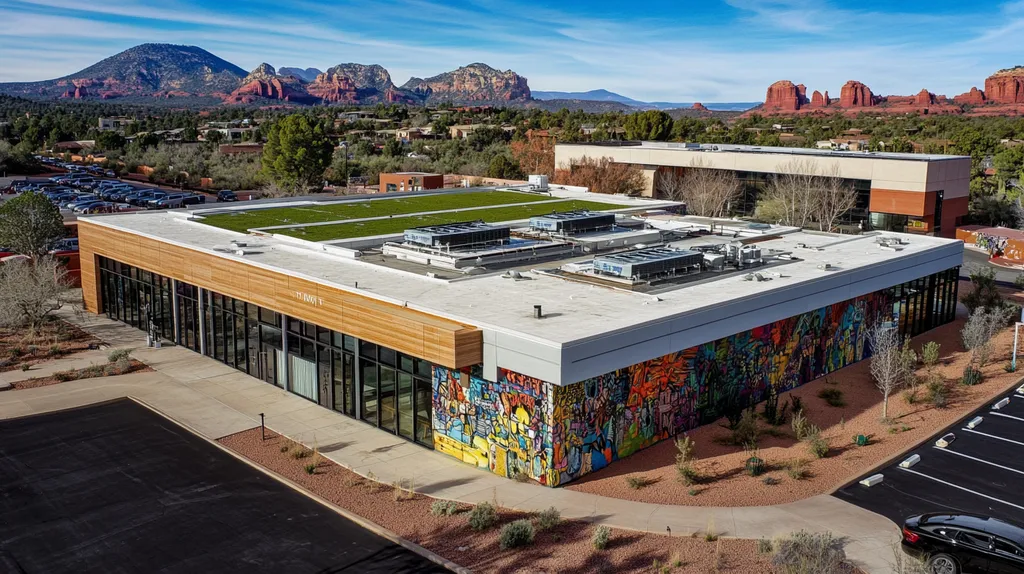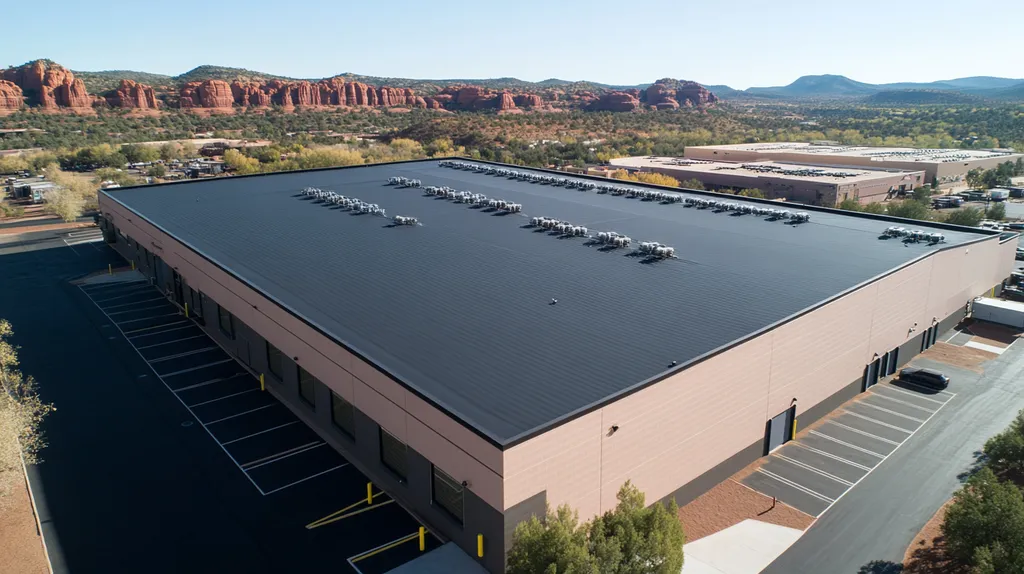In today’s commercial real estate market, a single roofing mistake can lead to hundreds of thousands in damage and lost revenue. Recent industry data shows that 40% of building owners significantly underestimate their roofing material costs by focusing solely on upfront pricing.
From energy efficiency to long-term durability, the choice of roofing materials impacts every aspect of a commercial building’s performance and value. Yet widespread misconceptions continue driving poor decisions that compromise building integrity.
This comprehensive guide cuts through the confusion, providing property owners with clear, evidence-based insights into material costs, performance factors, and long-term implications of their roofing choices.
SECTION 1: COMMON MISCONCEPTIONS
When it comes to choosing the right roofing options, property owners are often faced with decisions that have lasting impacts on their finances and the integrity of their buildings. A report from the National Roofing Contractors Association highlights that opting for inferior materials can lead to skyrocketing repair costs and decreased energy efficiency. It’s crucial to debunk common misconceptions about roofing materials so that property owners can make the best choices. This section tackles the pitfalls of selecting cheap materials, clarifies roof lifespan and durability, and emphasizes the significance of considering local climate and regulations.
Myth: Cheap Materials Are Always Best
Many property owners believe that selecting the least expensive roofing materials will help them save money. This assumption can be dangerously misleading. The low upfront cost of cheap materials often conceals potential long-term issues, such as recurring repairs and poor energy performance.
For example, lower-quality materials typically lack the resilience to withstand extreme weather conditions. This can result in premature wear and tear, leading to costly repairs or even replacements more often than expected.
On the other hand, investing in higher-quality roofing materials provides better protection and longevity. This smart investment can lead to significant savings over the life of the roof, as more durable materials often negate the need for frequent maintenance.
Property owners must carefully evaluate the short-term savings of choosing cheaper options against the potential long-term financial burdens. A thoughtful assessment can justify a larger initial investment in superior roofing materials.
Misunderstanding Roof Lifespan and Durability
Another widespread misconception is that all roofing materials have similar lifespans. In reality, different types of roofing vary significantly in durability and longevity. For instance, traditional asphalt shingles typically last between 15 to 30 years, while metal roofing can last upwards of 50 years.
Overlooking these differences can lead to misguided budget allocations and unexpected financial strains later on. Being aware of the varying lifespans means property owners can make an informed decision that alleviates the need for frequent replacements.
Additionally, it’s essential to recognize that certain materials perform better in specific environments. A flat roofing system may require different considerations than a sloped one, directly impacting durability and lifespan. Careful consideration of the unique characteristics of each material is crucial.
Failing to understand these nuances could result in significant costs in the future. Gaining knowledge about material lifespans empowers property owners to make wise choices that benefit their buildings.
Ignoring Local Climate and Regulations
Many property owners underestimate the critical influence of local climate and building codes on their roofing decisions. Certain materials may excel in mild climates but perform poorly under extreme conditions, posing a risk to long-term functionality.
In areas prone to heavy rainfall or snow, choosing a roofing material that is not moisture-resistant can lead to severe structural problems. Such choices can translate to higher maintenance costs and potential damage to the building’s interior.
Moreover, adhering to local building codes is not merely a formality; it can prevent costly fines and the need for expensive rework down the line. Neglecting these regulations can necessitate the replacement of improperly installed roofing materials and additional costs.
This oversight emphasizes the importance of consulting with roofing professionals who have a grasp of local conditions and regulations. By doing so, property owners can choose materials that are resilient to environmental challenges and compliant with local codes.
SECTION 2: PRACTICAL IMPLICATIONS
Understanding the implications of different commercial roofing materials is not just a detail; it’s a necessity for property owners. A hasty or uninformed choice can trigger soaring maintenance expenses, inflated utility bills, and a decline in property value. For instance, studies show that an average flat roof can last only 10-15 years without proper upkeep, leading to unanticipated costs. This section delves into how roofing material impacts maintenance and repair costs, energy efficiency, and the overall appeal of a property.
Impact on Maintenance and Repair Costs
The type of roofing material selected plays a significant role in determining maintenance and repair costs. For example, single-ply membranes like TPO or EPDM are often easier to maintain compared to traditional built-up roofing systems. However, neglecting regular upkeep can lead even these newer materials to incur costly repairs over time.
Quality materials, such as metal roofs, frequently boast longer lifespans and warranties that can extend up to 50 years. This durability translates to lower frequencies of repairs and replacements, establishing them as a savvy long-term investment for property owners.
Conversely, opting for cheaper materials might result in lower initial expenditures but can lead to escalated repair costs down the line. Regular inspections and proactive maintenance become crucial for extending the lifespan of these roofs, adding to the overall financial burden.
Ultimately, weighing the initial costs against the potential maintenance needs is essential for solid long-term financial planning for property owners.
Effects on Energy Efficiency and Utility Bills
The energy efficiency of roofing materials has a profound impact on utility costs. For instance, reflective roofing options, such as white TPO or PVC, can lower cooling expenses by reflecting, rather than absorbing, solar heat. These energy-efficient roofs can lead to reductions of up to 20% in energy bills, providing immediate financial relief.
In contrast, traditional dark roofing materials tend to trap heat, forcing air conditioning systems to work harder. This results in higher energy expenses, particularly in warmer climates where cooling costs can dominate operational budgets.
Investing in energy-efficient roofing materials also aligns with sustainability goals, boosting a property’s reputation and attractiveness. As eco-conscious features become increasingly prioritized, the value of high-performance roofing systems rises.
Understanding how roofing materials affect energy performance is vital. It empowers property owners to make informed choices that positively impact both their costs and environmental objectives.
Influence on Property Value and Aesthetics
The selection of roofing material can dramatically influence property aesthetics and market value. A visually appealing, well-maintained roof enhances a building’s curb appeal, making it more enticing to prospective tenants or buyers. Premium options like modern metal or slate roofs are often regarded as attractive upgrades that elevate a property’s overall appearance.
In stark contrast, aging or neglected roofing can diminish a building’s value. Prospective buyers may be deterred by looming repair or replacement needs, leading to reduced offers. Commercial properties featuring attractive roofing designs are more likely to command higher rental rates and sale prices.
Furthermore, properties investing in energy-efficient roofs are increasingly sought after in competitive rental markets. Features such as green roofs or living walls not only enrich aesthetics but resonate with environmentally conscious tenants.
In summary, property owners must realize that roofing decisions extend far beyond functionality; they significantly impact property value and visual appeal. This understanding makes it essential to factor in aesthetics when making roofing choices.
SECTION 3: COST OF MISINFORMATION
The repercussions of choosing the wrong roofing materials can be staggering for property owners, leading to hidden costs that can compound over time. The implications of a poor roofing decision don’t just end at the installation; research shows maintenance costs can soar by as much as 60% if inferior materials are selected. This section dives into the financial consequences of poor choices, the additional labor costs tied to incorrect installations, and the long-term expenses that accompany frequent repairs.
Financial Consequences of Poor Material Choices
Selecting the wrong roofing materials can wreak havoc on a property owner’s budget. While cheaper options might seem attractive at first glance, they rarely stand the test of time and often lead to higher overall costs. Take, for example, a facility that installed a low-grade thermoplastic roofing system. It developed leaks within a few years, forcing the owner to spend significantly on patching and repairs, making the initial savings seem trivial.
It’s essential to factor in hidden costs, like the potential loss of revenue during extended repair periods. When the roof fails, operations can grind to a halt, causing business disruption and loss. Investors must choose wisely, as the long-term benefits of quality materials far outweigh short-term savings, leading to better value over the lifespan of the roof.
Labor Costs Associated with Incorrect Installations
When misunderstandings around roofing materials lead to incorrect installations, the resulting labor costs can skyrocket. An improper setup often necessitates additional manpower to rectify mistakes, burdening project budgets. For instance, a facility manager might choose a complex roofing system without grasping the intricacies of its installation, inadvertently causing a poorly functioning roof that demands specialized contractors for correction.
Moreover, poor installations can result in safety hazards that require urgent attention. The unexpected need for rework can not only strain resources but also delay normal operations, incurring additional costs. Initial savings on labor can quickly evaporate, underscoring the importance of informed planning and clear communication throughout the installation process.
Long-Term Expenses of Frequent Repairs
The financial cycle induced by frequent roofing repairs can be relentless for property owners. Each repair demands not only a financial outlay but also creates disruptions that impact daily business operations. For instance, a commercial property with ongoing roof leaks may incur both elevated maintenance costs and revenue losses stemming from downtime during repairs, further eroding profits.
Over time, the cumulative cost of these recurring repairs can surpass what it would have cost to invest in high-quality materials upfront. Delaying the decision to opt for durable options can produce a vicious cycle of ongoing maintenance expenses. Ultimately, property owners must understand that the long-term impact of repairs may far exceed any initial cost savings from selecting cheaper materials, prompting reevaluation of their roofing decisions.
SECTION 4: REALITY CHECK
The financial stakes involved in selecting the right commercial roofing material are significant, with costs fluctuating widely. Industry reports indicate that average material expenses can range from $3 to $8 per square foot, and when labor costs are factored in, the total can easily double. For property owners and facility managers, it’s essential to evaluate these costs in relation to quality and longevity. A well-informed choice can drastically influence overall budgets and long-term investments in roofing solutions.
Understanding Material Costs Per Square Foot
Material costs form the backbone of any roofing budget. Depending on the type of materials, expenses can vary greatly. For instance, roofing materials like asphalt shingles typically cost around $4 per square foot, while more durable choices such as metal or TPO often exceed $7 per square foot. This price variation reflects not only the longevity of the materials but also their effectiveness under different weather conditions.
A flat roofing system using EPDM averages $5 per square foot, which is generally less expensive than built-up roofing (BUR) at around $6.50 per square foot. However, the installation expenses can quickly escalate, making it crucial to select materials based on their long-term value rather than their initial price point.
Moreover, higher-quality materials can yield future savings by reducing maintenance needs and extending the lifespan of the roof. This understanding is vital for making budget-conscious decisions in facilities management.
Labor Costs and Contractor Expertise
Labor costs can significantly impact overall roofing expenses, so it’s vital to consider the expertise of the contractor hired for the job. Skilled labor rates can range from $50 to $150 per hour, depending on location and complexity of the project. Property owners must understand that opting for cheaper labor can lead to shoddy workmanship, resulting in heightened long-term costs due to repairs and replacements.
Inadequate installation can void warranties and lead to early failures, making it essential to thoroughly assess contractor qualifications. While hiring experienced contractors may imply higher upfront expenses, the payoff often includes fewer issues throughout the roof’s lifespan. When comparing labor quotes, both pricing and contractor experience must be taken into account.
The roofing material choice can also affect labor costs. More complex systems, like slate, typically require specialized skills, whereas simpler materials, such as TPO, are often easier to install. Including labor costs in the overall budget from the start ensures a well-rounded understanding of roofing investments.
Compliance with Local Building Codes
Local building codes can have a considerable impact on costs and material selection. Understanding these regulations is crucial; non-compliance can lead to fines and expensive rework. Various jurisdictions may impose specific requirements regarding fire resistance, energy efficiency, and roof slope that must be factored in during the material selection process.
For example, selecting materials that meet energy efficiency standards may open the door to energy rebate opportunities. Conversely, failure to comply could necessitate costly redesigns or introduce safety hazards. Compliance is not just a legal consideration; it ensures that the building remains operable and safe.
Additionally, hiring local contractors who understand these regulations can streamline the roofing process. They can provide valuable insights into the best materials that conform to local codes, potentially resulting in cost savings. The importance of acknowledging and adhering to local building codes cannot be overstated in this decision-making process.
SECTION 5: EVIDENCE-BASED ALTERNATIVES
Choosing the right roofing material is crucial—this decision can have financial implications affecting property performance for decades. A solid roofing choice minimizes operational costs over time while ensuring durability. By exploring options like single-ply membranes, metal, and modified bitumen roofs, property owners can identify the material that best meets their specific needs and enhances their investments.
Evaluating Single-Ply Membranes (TPO, PVC, EPDM)
Single-ply membranes, including TPO, PVC, and EPDM, are rising stars in commercial roofing for their adaptability and easy installation. TPO offers impressive reflective properties that can significantly reduce cooling costs during the hot months, while PVC stands out for its unmatched durability and chemical resistance. EPDM remains a go-to for flat roofs, appreciated for its affordability and longevity.
Yet, each membrane has its challenges. TPO, with its exceptional energy efficiency, can suffer from splitting issues over time. PVC tends to have a higher upfront cost, presenting budget concerns for some owners. EPDM, while economical, may lack the visual appeal some property owners desire. Assessing these characteristics against specific climate and building requirements is essential.
Equally important are long-term warranties and the availability of skilled local installers, which significantly enhance the overall appeal of these membranes. In areas facing extreme weather, the right choice can mitigate risks effectively and ensure lasting performance. Thus, understanding these nuances is crucial for maximizing a roof’s life cycle.
In conclusion, careful evaluation of single-ply membranes enables property owners to make informed and strategic roofing decisions that serve their long-term interests.
Benefits and Drawbacks of Metal Roofing
Metal roofing has emerged as a favored choice for commercial property owners seeking durability and a long lifespan. Known for its incredible resilience against severe weather, metal roofs often exceed 50 years, substantially lowering replacement costs. Their reflective nature can lead to energy savings, helping lower utility bills to keep operational budgets in check.
However, potential downsides merit attention. The initial installation costs can be higher compared to other materials, which might deter cost-sensitive property owners. Additionally, metal roofing can face denting from hail or falling debris, which necessitates ongoing maintenance and occasional repairs.
On the positive side, metal roofing offers remarkable design flexibility, coming in various colors and styles. This versatility allows property managers to enhance aesthetics while maintaining functionality, ultimately boosting property value. Selecting the right type of metal is key, as not all metals deliver the same performance levels.
In summary, metal roofing provides a reliable, long-term solution for those prepared to invest upfront. By understanding the balance between advantages and disadvantages, property owners can make well-informed choices that meet their unique needs.
Advantages of Modified Bitumen and Built-Up Roofs
Modified bitumen and built-up roofs (BUR) remain relevant choices in commercial roofing. Modified bitumen roofs enhance waterproofing and flexibility, making them ideal for areas with heavy foot traffic. Their multi-layered construction offers added durability, particularly beneficial for flat roofs.
BUR systems are celebrated for their reliability, boasting a proven track record of performance. By layering asphalt with felts, these roofs achieve superior weather resistance and longevity, often lasting 20 years or more—making them an excellent choice for those seeking stability.
Nonetheless, these systems can be labor-intensive to install, leading to higher upfront costs. The requirement for skilled labor can introduce potential delays in project timelines. Furthermore, regular inspections and maintenance are vital for preserving functionality over the lifespan of the roof.
Ultimately, when evaluating modified bitumen and BUR options, property owners should consider long-term strategies and financial commitments. A thorough understanding of installation processes and ongoing maintenance requirements is invaluable for maximizing their investment’s value.
SECTION 6: TEST AND VERIFY
In the competitive landscape of commercial roofing, making informed choices is critical to safeguarding investments. A flawed roofing material decision can lead to spiraling repair costs, diminished revenue, and even dangerous conditions for building occupants. With roofs accounting for nearly 40% of a building’s energy consumption, thorough assessments are paramount before making selections. This section emphasizes three vital actions: conducting comprehensive roof inspections, testing material durability, and verifying contractor credentials.
Conducting Thorough Roof Inspections
The first step in any effective roofing strategy is a detailed inspection. Engaging a qualified inspector can uncover hidden problems such as leaks, structural damage, or insulation deficiencies. Inspections should encompass not only the surface of the roof but also internal components like drainage systems.
Regular inspections are essential to maintaining roof performance and extending its lifespan. According to the National Roofing Contractors Association (NRCA), roofs that receive ongoing maintenance can last significantly longer than those that are neglected. Skipping inspections can result in more severe and costly repairs later.
Documenting each inspection is crucial. This should include photographs, condition reports, and suggested repairs. Keeping meticulous records aids in informed decision-making and future maintenance planning.
Investing in thorough inspections delivers long-term savings. By proactively addressing issues, property owners can ensure their roofs operate efficiently for years ahead.
Testing Material Durability and Performance
Selecting the right material is just one part of the equation; understanding its performance in real-world conditions is equally vital. Factors like UV exposure, heavy rain, and wind can affect materials significantly over time.
Third-party testing organizations provide valuable data on various roofing products. Performance ratings and benchmarks are often included in product specifications. Materials that have successfully passed rigorous tests typically demonstrate enhanced durability under challenging environmental conditions.
Manufacturers offering warranties can also reflect the reliability of their materials. These warranties provide peace of mind to property owners, ensuring coverage against potential failures. By considering test results during material selection, property owners can make informed, confident decisions.
Sustainability and energy efficiency are crucial considerations as well. Roofing solutions that reflect sunlight or incorporate environmentally friendly materials can decrease energy costs while minimizing ecological impact.
Verifying Contractor Credentials and Reviews
No matter how high-quality materials may be, skilled installation is essential. Therefore, verifying contractor credentials is a critical step in the roofing process. Property owners should confirm licensing, insurance, and certifications to ensure that they’re engaging a qualified contractor.
Investigating past projects and client testimonials can shed light on a contractor’s reliability. Websites aggregating customer reviews can be invaluable in assessing reputation. A contractor with a strong record of satisfied clients generally represents a safer choice.
Additionally, requesting references and inspection reports from prior work adds transparency and highlights contractor capabilities. Engaging directly with past clients can yield essential insights into performance and trustworthiness.
Collaborating with a reputable contractor is crucial to ensuring that the selected roofing system is installed correctly. Well-verified credentials and positive reviews create a strong foundation against unforeseen challenges.
The Bottom Line
With commercial roofing costs ranging from $50,000 to over $1 million per project, selecting the right materials has never been more critical for building owners and facility managers.
Industry data shows that 40% of roof failures stem directly from poor material choices, leading to billions in preventable damage annually across the commercial sector.
The evidence is clear: successful roofing projects require a comprehensive understanding of material costs, performance characteristics, and installation requirements.
By moving beyond common misconceptions and embracing evidence-based alternatives, property owners can maximize their roofing investments while ensuring optimal building protection.
The future of commercial roofing lies in informed decision-making that balances initial costs against long-term performance, sustainability, and value creation.
FREQUENTLY ASKED QUESTIONS
Q. What are common misconceptions about commercial roof materials?
A. Many believe that opting for the cheapest materials saves money, but this often leads to higher repair costs and lower energy efficiency over time. Inferior materials may lack the durability needed to withstand extreme weather, resulting in more frequent replacements. A thoughtful investment in quality materials can extend roof lifespan and reduce long-term expenses.
Q. How do commercial roof materials impact maintenance costs?
A. The choice of roofing material significantly affects maintenance and repair costs. For instance, single-ply membranes like TPO can be easier to maintain compared to built-up roofs. Investing in durable materials can minimize repair frequency and extend lifespan, providing substantial savings compared to low-cost options that may require constant upkeep.
Q. What are the financial consequences of poor roofing material decisions?
A. Choosing inferior materials can lead to escalating costs, including higher maintenance and repair expenses. For example, a facility may face significant costs if leaks develop shortly after installation. Long-term financial planning requires selecting quality materials that promise durability and lower ongoing expenses.
Q. How do labor costs affect the overall roofing budget?
A. Labor costs can drastically influence the total expense of a roofing project. Qualified contractors may charge higher rates, but their expertise can prevent costly errors due to improper installation. An investment in skilled labor enhances the likelihood of a durable roof and minimizes future repair costs.
Q. What are the benefits of single-ply membrane roofing systems?
A. Single-ply membranes such as TPO, PVC, and EPDM offer remarkable adaptability while ensuring easy installation and long-lasting performance. They provide excellent energy efficiency, which can lead to substantial savings on cooling costs. However, each membrane has specific characteristics, so discerning property owners should match materials to their unique environmental challenges.
Q. Why is testing the durability of roofing materials essential?
A. Understanding the durability of selected roofing materials is pivotal for long-term success. Environmental conditions can greatly affect material performance, thus verifying their durability through third-party testing is crucial. Materials that pass rigorous tests usually indicate enhanced reliability and longevity, helping owners make well-informed decisions that stabilize their investments.
Q. How can building owners verify contractor credentials effectively?
A. Verifying contractor credentials is vital for ensuring quality installation. Property owners should check licensure, insurance, and past project successes. Gathering client testimonials, references, and firsthand reviews can provide essential insights into the contractor’s reliability, helping owners select a trustworthy partner for their roofing needs.










